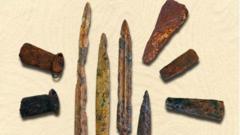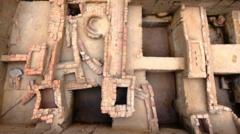Recent excavations in Tamil Nadu's ancient sites have produced evidence suggesting that the region may hold one of the earliest examples of iron production, possibly predating known sites in Turkey by centuries.
**Did Tamil Nadu Spark the Iron Age? Recent Discoveries Prompt Scholarly Debate**

**Did Tamil Nadu Spark the Iron Age? Recent Discoveries Prompt Scholarly Debate**
New archaeological findings in Tamil Nadu, India, suggest a much earlier onset of iron production than previously believed, igniting discussions on the origins of the Iron Age.
Over two decades of research have progressed dramatically in Tamil Nadu, revealing early written scripts, complex trade routes, and urban centers that paint a picture of advanced civilizations. The latest discoveries, however, focus on iron artifacts unearthed from six significant sites, including Adichchanallur and Mayiladumparai, dating between 2953 and 3345 BCE, which could imply that iron smelting techniques developed independently in the Indian subcontinent.
Dilip Kumar Chakrabarti, a professor at Cambridge University, described the findings as groundbreaking, indicating they could reformulate existing historical timelines regarding iron usage. Parth R Chauhan from the Indian Institute of Science Education and Research (ISER) recommends caution, suggesting that iron technologies likely appeared concurrently in various regions worldwide due to unevenly distributed archaeological exploration.
The archaeologists have discovered sophisticated iron-making techniques, including an ancient smelting furnace at the Kodumanal site, which shows evidence of advanced metallurgical skills. Additionally, finds such as a centuries-old iron sword and extensive iron tools—spanning 85 individual items at burial sites—underline the technological sophistication of the community.
Although prior evidence confirms iron production as far back as 4,200 years in India, these new findings deepen the historical narrative. They suggest that the knowledge of iron technology had developed independently in Tamil Nadu much earlier, challenging prevailing theories about singular origins of the Iron Age.
Experts celebrate these findings as crucial to understanding the broader context of technological advances and social structures in ancient Indian civilizations. Nonetheless, they urge that comprehensive excavations across India are necessary to fill gaps in our knowledge of iron production and to establish a fuller historical account.
Ultimately, these discoveries elevate Tamil Nadu's status in archaeological scholarship, suggesting it was not merely a consumer of iron technology but a pioneer in its production—an important assertion for the Indian historical narrative. As research continues, scholars urge an exploration of the broader implications of these findings on our understanding of the Iron Age and its global timeline.
Dilip Kumar Chakrabarti, a professor at Cambridge University, described the findings as groundbreaking, indicating they could reformulate existing historical timelines regarding iron usage. Parth R Chauhan from the Indian Institute of Science Education and Research (ISER) recommends caution, suggesting that iron technologies likely appeared concurrently in various regions worldwide due to unevenly distributed archaeological exploration.
The archaeologists have discovered sophisticated iron-making techniques, including an ancient smelting furnace at the Kodumanal site, which shows evidence of advanced metallurgical skills. Additionally, finds such as a centuries-old iron sword and extensive iron tools—spanning 85 individual items at burial sites—underline the technological sophistication of the community.
Although prior evidence confirms iron production as far back as 4,200 years in India, these new findings deepen the historical narrative. They suggest that the knowledge of iron technology had developed independently in Tamil Nadu much earlier, challenging prevailing theories about singular origins of the Iron Age.
Experts celebrate these findings as crucial to understanding the broader context of technological advances and social structures in ancient Indian civilizations. Nonetheless, they urge that comprehensive excavations across India are necessary to fill gaps in our knowledge of iron production and to establish a fuller historical account.
Ultimately, these discoveries elevate Tamil Nadu's status in archaeological scholarship, suggesting it was not merely a consumer of iron technology but a pioneer in its production—an important assertion for the Indian historical narrative. As research continues, scholars urge an exploration of the broader implications of these findings on our understanding of the Iron Age and its global timeline.



















